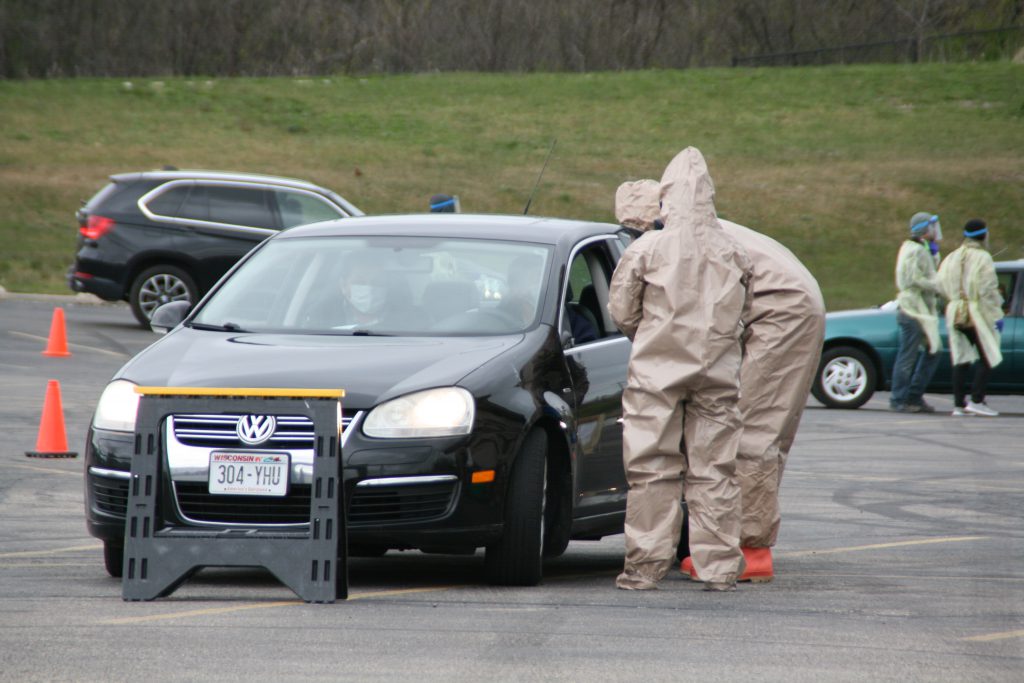Milwaukee County Currently Suppressing COVID-19
New cases continue to go down as R-value is below 1.

Wisconsin National Guard individuals man a COVID-19 testing facility in Bay View. Photo by Jeramey Jannene.
Similar to statewide trends, new cases of COVID-19 are going down following a massive spike in July.
In the city of Milwaukee, daily new cases of COVID-19 are dropping approximately to where they were before the spike in July. In Milwaukee County’s suburbs, however, daily new cases have still not dropped to where they were before the spike.
Darren Rausch, director of the City of Greenfield Health Department, said, “The suburban communities… have had a lot of disease since July first and that trend continues to hold pretty steady but on a little bit of a downward trajectory.”
Rausch has been working with a team of epidemiologists from the Medical College of Wisconsin (MCW) to track the disease locally.
The growth rate of the virus is also slowing down slightly. In the latest report from the MCW team, the doubling time increased by five days from the previous week and now stands at 60 days. It is less than 40 days for the state. The doubling rate measures how long it takes the number of cases to double. “Longer doubling times are better,” says a legend on the graph.
Both testing and the percentage of tests coming back positive are down. This past week, the share of tests that came back positive was 7.0 percent, down from last week’s 7.4 percent.
While the trends in cases and transmission are positive, seeing testing numbers go down is not. Widespread testing is the most effective way to track and isolate disease in the community. “We must be cautious with our optimism,” said Dr. Ben Weston, Milwaukee County director of emergency medical services.
The demographics of COVID-19 transmission have not changed much. Young people continue to have the highest number of cases and the highest rates of disease.
And the county’s Hispanic population continues to have the most cases of any sub-population in the county.
Last week, Urban Milwaukee reported that there were hotspots of disease on the city’s South Side and in the county’s southern suburbs, notably Oak Creek. That remains the same, however, there is also a growing hotspot on the Northwestern Side of the city.
A full copy of the report is available on Urban Milwaukee.
If you think stories like this are important, become a member of Urban Milwaukee and help support real, independent journalism. Plus you get some cool added benefits.
More about the Coronavirus Pandemic
- Governors Tony Evers, JB Pritzker, Tim Walz, and Gretchen Whitmer Issue a Joint Statement Concerning Reports that Donald Trump Gave Russian Dictator Putin American COVID-19 Supplies - Gov. Tony Evers - Oct 11th, 2024
- MHD Release: Milwaukee Health Department Launches COVID-19 Wastewater Testing Dashboard - City of Milwaukee Health Department - Jan 23rd, 2024
- Milwaukee County Announces New Policies Related to COVID-19 Pandemic - David Crowley - May 9th, 2023
- DHS Details End of Emergency COVID-19 Response - Wisconsin Department of Health Services - Apr 26th, 2023
- Milwaukee Health Department Announces Upcoming Changes to COVID-19 Services - City of Milwaukee Health Department - Mar 17th, 2023
- Fitzgerald Applauds Passage of COVID-19 Origin Act - U.S. Rep. Scott Fitzgerald - Mar 10th, 2023
- DHS Expands Free COVID-19 Testing Program - Wisconsin Department of Health Services - Feb 10th, 2023
- MKE County: COVID-19 Hospitalizations Rising - Graham Kilmer - Jan 16th, 2023
- Not Enough Getting Bivalent Booster Shots, State Health Officials Warn - Gaby Vinick - Dec 26th, 2022
- Nearly All Wisconsinites Age 6 Months and Older Now Eligible for Updated COVID-19 Vaccine - Wisconsin Department of Health Services - Dec 15th, 2022
Read more about Coronavirus Pandemic here





















